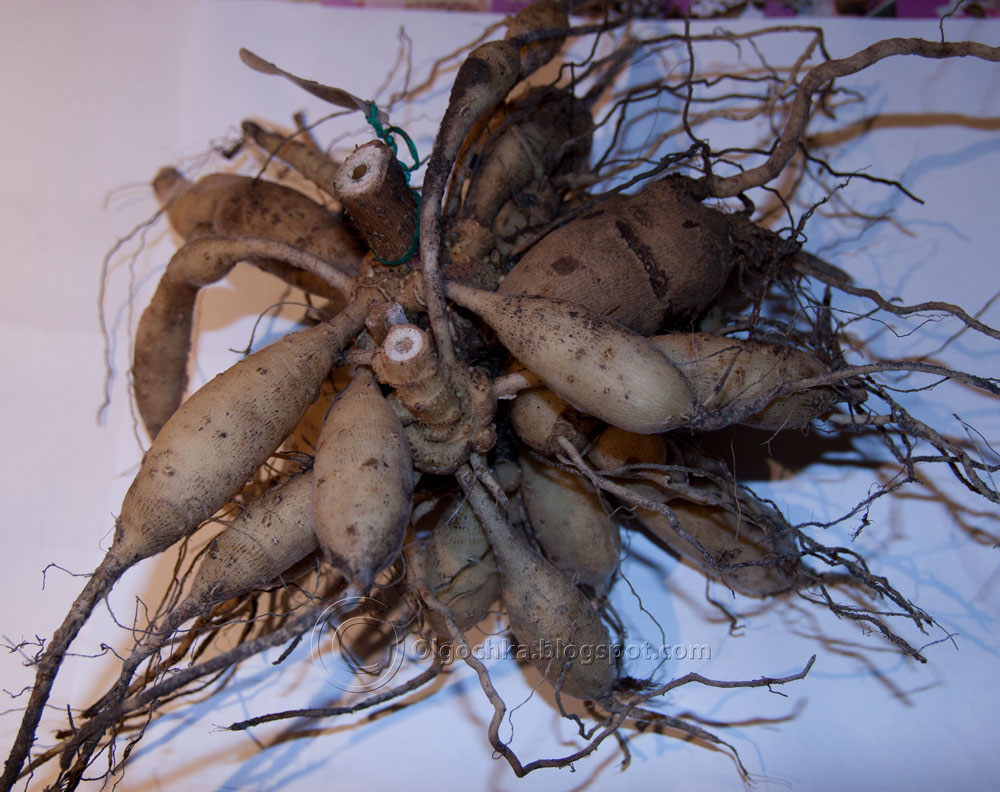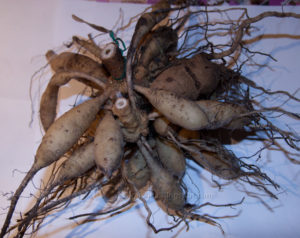
Be-a-Better-Gardener
Autumn Tips: Preparing Tender Bulbs for Winter
Dahlia tubers ready for storage
By Thomas Christopher
The party’s over. At least, the bloom in the fall flower garden is finally coming to an end. A handful of asters or chrysanthemums may hang on undiminished by the first fall frost, but all the tropical or semi-tropical perennials that have filled the beds with bold foliage and flamboyant colors all summer long and into autumn lie black and wilted like lettuce left too long in the crisper drawer. And if your garden has somehow escaped frost until now, be sure that it is coming soon.
Take heart, though. Below those frost-bitten remnants lie roots and bulbs that can be rescued and over-wintered to provide a new show of tropical exuberance next summer. Here are a few examples of garden favorites and how to winter them so you can enjoy them again next season.
Cannas (Canna spp.): Natives of the West Indies and South America, these can grow head-high with large, often brightly striped leaves and flamboyant blossoms. Best planted toward the back of a sunny border, they also flourish in conditions of partial shade, although they often do not bloom in lower-light sites. To over-winter, cut the frost-killed stems back to 6 inches or so and then carefully excavate the clumps roots and rhizomes. Shake off the excess soil, then place the clumps in cardboard cartons filled with peat moss – don’t moisten the peat as this will promote rot. Use a separate box for each type of canna and be sure to include a label specifying the name of each one’s contents. Store the boxes in a cool, frost-free, dry place, (50°F. is ideal) out of the sun, such as the back corner of an unheated basement. Mine stay a bit warmer than that (around 60°F.) and do just fine
Elephant’s Ears (Colocasia esculenta): A popular food crop in Polynesia and southeast Asia, this plant produces insignificant flowers. The leaves, however, are anything but – huge (to 3 ft. or more) and heart-shaped, they may be green, dark purple or variegated, depending on the cultivar.
Many types of elephant’s ears grow large, subterranean stem bases called corms. These can be dug and over-wintered like cannas. Some of the newer, fancy-leaved types such as ‘Black Magic’ don’t make corms and these should dug before the first fall frost, cut back to the two topmost leaves and overwintered in containers indoors in a sunny cool spot such as a frost-free sunroom.
Dahlias (Dahlia pinnata): Mexican by origin, dahlias have been bred into a myriad of forms so that their flowers may range in size, depending on the type, from 2 inches across to monsters fully a foot in diameter. I love their gaudy display and the fact that they bloom on into fall. They produce a potato-like cluster of tubers. Dig these carefully after the first frost – the tubers are easily damaged. Overwinter like cannas.
Bananas (Musa spp.): The most dramatic and atmospheric of tropical plants for the northern garden are also, in my experience, the easiest to overwinter.Before the first frost, cut off most of the leaves, leaving just one or two and the central bud. Then pop the plant out of the ground with a spade. Drop the roots into a plastic trash bag and set in a cool (ca. 50-60°F.), dark spot in your basement.
In late spring, when the soil in your garden has warmed, bring your boxes of rhizomes, corms and tubers out of storage. Large clumps may be ready for division. With cannas, you’ll need a sharp knife to slice off the larger rhizomes – make sure that each piece has at least two “eyes,” the prominent red buds that will develop into new stems. Large elephant’s ear corms may have sprouted smaller corms or offsets, and these may be detached with your knife and planted separately. Dahlia clumps can be divided by slicing the individual tubers off the central stem. Again, make sure that each tuber has growth eyes, which in dahlias are small protuberances near where the tuber attaches to the stem.
Thomas Christopher is the co-author of “Garden Revolution” (Timber Press, 2016) and is a volunteer at Berkshire Botanical Garden. berkshirebotanical.org
Be-a-Better-Gardener is a community service of Berkshire Botanical Garden, one of the nation’s oldest botanical gardens in Stockbridge, MA. Its mission to provide knowledge of gardening and the environment through 25 display gardens and a diverse range of classes informs and inspires thousands of students and visitors on horticultural topics every year. Thomas Christopher is the co-author of Garden Revolution (Timber press, 2016) and is a volunteer at Berkshire Botanical Garden. berkshirebotanical.org.



